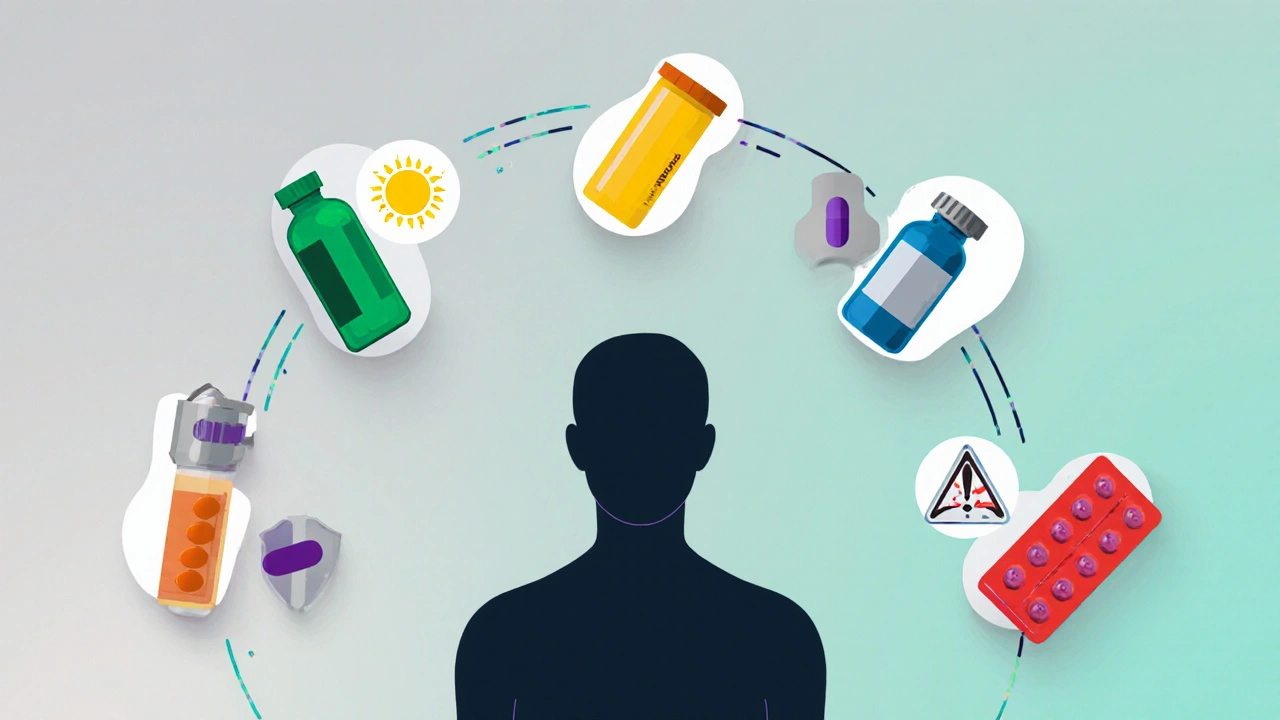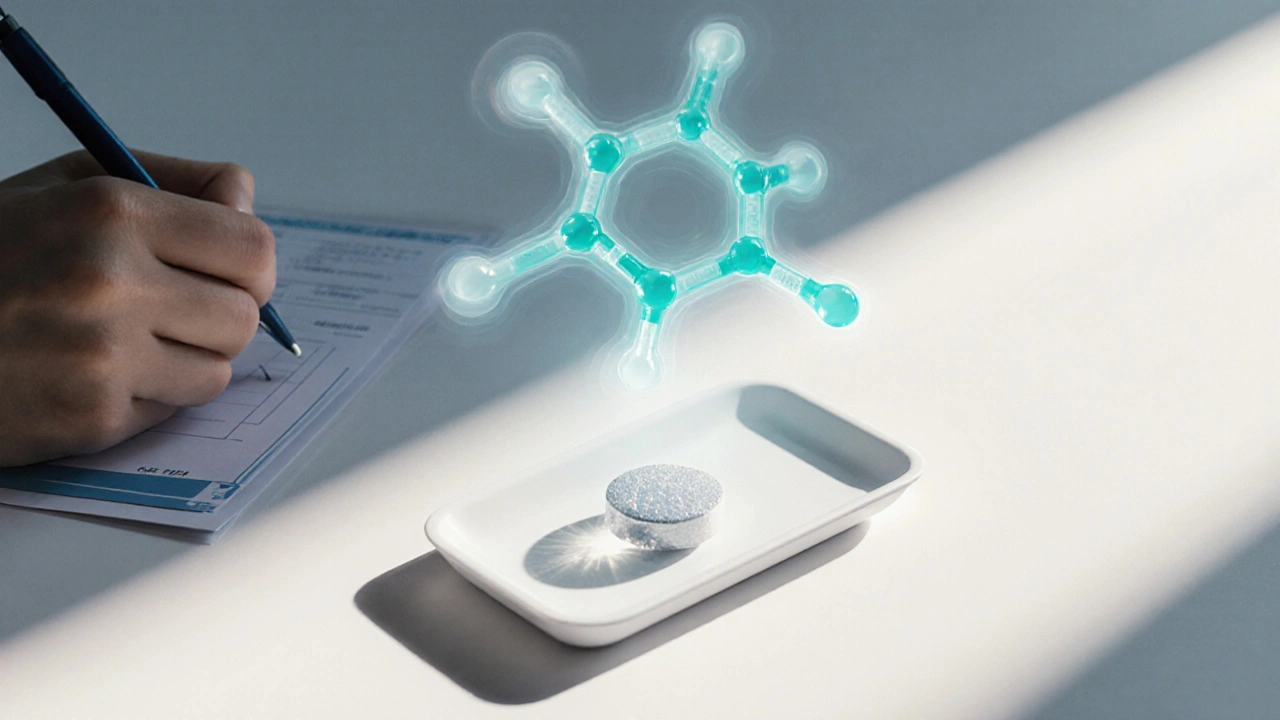Doxycycline vs. Antibiotic Alternatives Comparison Tool
Doxycycline Hyclate
Mechanism: Inhibits bacterial protein synthesis (bacteriostatic)
Spectrum: Effective against Gram-positive, Gram-negative, atypical organisms, and some protozoa
Typical Dose: 100 mg twice daily or 200 mg once daily
Side Effects: GI upset, photosensitivity, esophageal irritation
Select Alternative
Select an antibiotic from the dropdown to see detailed comparison with Doxycycline Hyclate.
When a doctor prescribes a broad‑spectrum antibiotic, many patients wonder if there’s a better option for their specific infection. antibiotic alternatives often sound appealing, but choosing the right one depends on the bug, the patient’s health, and the drug’s safety profile. Below, we break down Doxycycline Hyclate - a popular tetracycline derivative - and compare it side‑by‑side with five frequently used alternatives. By the end you’ll know when doxycycline shines, when another drug makes sense, and what trade‑offs to watch for.
Quick Take (TL;DR)
- Doxycycline Hyclate offers excellent coverage for atypical respiratory bugs, Lyme disease, and acne, with a convenient once‑daily dose.
- Azithromycin is a good alternative for patients who need a short course or have trouble tolerating doxycycline’s stomach upset.
- Amoxicillin remains first‑line for many ear, sinus, and throat infections but lacks activity against intracellular pathogens.
- Minocycline provides stronger anti‑inflammatory effects for acne but carries higher risk of pigment changes.
- Clindamycin is useful for anaerobic infections and skin‑soft‑tissue infections, yet it raises the chance of C. difficile colitis.
- Levofloxacin is a potent fluoroquinolone reserved for resistant cases because of tendon‑rupture and cardiac‑risk warnings.
What Is Doxycycline Hyclate?
Doxycycline Hyclate is a semi‑synthetic, broad‑spectrum tetracycline antibiotic that works by binding to the 30S ribosomal subunit of bacteria, blocking protein synthesis. First approved in the early 1960s, the hyclate salt improves water solubility, allowing reliable oral absorption of about 95%.
Key attributes:
- Mechanism: Inhibits bacterial protein synthesis (bacteriostatic).
- Spectrum: Effective against Gram‑positive, Gram‑negative, atypical organisms (e.g., Mycoplasma pneumoniae, Chlamydia trachomatis), and some protozoa.
- Typical adult dose: 100mg twice daily for 7-14days, or 200mg once daily for certain indications.
- Common side effects: Gastro‑intestinal upset, photosensitivity, esophageal irritation.
- Contraindications: Pregnancy after week4, children <8years (teeth staining), severe hepatic impairment.
Top Alternatives to Doxycycline
Each alternative belongs to a different drug class, offering distinct strengths and weaknesses. Below is a snapshot of the most common substitutes.
Azithromycin - a macrolide antibiotic
Azithromycin binds to the 50S ribosomal subunit, halting bacterial protein elongation. It’s prized for a long half‑life, enabling once‑daily dosing for 3‑5days.
- Typical uses: Community‑acquired pneumonia, chlamydia, travel‑related diarrhea.
- Dose: 500mg day1, then 250mg daily for 4days.
- Pros: Fewer GI complaints, good for patients who experience doxycycline‑induced nausea.
- Cons: Limited activity against Rickettsia and some resistant strains; can cause QT prolongation.
Amoxicillin - a penicillin‑type beta‑lactam
Amoxicillin interferes with bacterial cell‑wall synthesis, making it bactericidal. It remains a first‑line agent for many upper‑respiratory infections.
- Typical uses: Otitis media, sinusitis, strep throat, uncomplicated dental infections.
- Dose: 500mg three times daily or 875mg twice daily for 7-10days.
- Pros: Well‑tolerated, inexpensive, excellent safety in pregnancy.
- Cons: No coverage for atypical intracellular pathogens; resistance rising in H. influenzae.
Minocycline - a second‑generation tetracycline
Minocycline shares the same ribosomal target as doxycycline but penetrates tissues better and has anti‑inflammatory properties.
- Typical uses: Moderate‑to‑severe acne, rheumatoid arthritis adjunct, certain rickettsial infections.
- Dose: 100mg twice daily.
- Pros: Stronger effect on inflammatory lesions, less photosensitivity.
- Cons: Higher incidence of vestibular side effects, rare autoimmune hepatitis, and pigmentary changes.
Clindamycin - a lincosamide antibiotic
Clindamycin blocks the 50S subunit, similar to macrolides, and is especially good against anaerobes.
- Typical uses: Skin‑soft‑tissue infections, dental abscesses, MRSA‑susceptible infections.
- Dose: 300mg four times daily or 600mg twice daily.
- Pros: Excellent tissue penetration, covers many Gram‑positive anaerobes.
- Cons: Highest risk among these agents for Clostridioides difficile colitis; GI upset common.
Levofloxacin - a fluoroquinolone
Levofloxacin interferes with bacterial DNA gyrase and topoisomerase IV, making it bactericidal and highly potent.
- Typical uses: Complicated urinary tract infections, chronic prostatitis, multidrug‑resistant pneumonia.
- Dose: 500mg once daily for 5-10days.
- Pros: Broad coverage, excellent bioavailability, handy single‑daily dose.
- Cons: Black‑box warnings for tendon rupture, aortic aneurysm, QT prolongation; should be reserved for resistant cases.

Comparative Table
| Attribute | Doxycycline Hyclate | Azithromycin | Amoxicillin | Minocycline | Clindamycin | Levofloxacin |
|---|---|---|---|---|---|---|
| Class | Tetracycline | Macrolide | Penicillin | Second‑gen. Tetracycline | Lincosamide | Fluoroquinolone |
| Mechanism | 30S ribosomal inhibition | 50S inhibition | Cell‑wall synthesis inhibition | 30S inhibition | 50S inhibition | DNA gyrase/topoisomerase inhibition |
| Typical Dose (adult) | 100mg BID or 200mg QD | 500mg day1, then 250mg QD | 500mg TID or 875mg BID | 100mg BID | 300mg QID or 600mg BID | 500mg QD |
| Duration (common) | 7-14days | 3-5days | 7-10days | 4-6weeks (acne) | 7-10days | 5-10days |
| Key Targets | Atypicals, rickettsia, Lyme | Typical & atypicals (limited) | Strep, H. flu, otitis media | Acne, rickettsia | Anaerobes, MRSA (susceptible) | Broad (including Pseudomonas) |
| Photosensitivity | High | Low | None | Moderate | None | Low |
| Pregnancy Safety (1st trim) | Contraindicated | Generally safe | Safe | Contraindicated | Category C | Category C (use caution) |
| Cost (US average) | $0.30/tablet | $1.20/tablet | $0.15/tablet | $0.45/tablet | $1.00/tablet | $1.80/tablet |
| Common Side Effects | GI upset, photosensitivity | GI upset, QT prolongation | Rash, GI upset | Vertigo, hyperpigmentation | C. difficile, GI upset | Tendon injury, CNS effects |
How to Choose the Right Antibiotic
Choosing an antibiotic isn’t a one‑size‑fits‑all decision. Consider these three practical axes:
- Pathogen profile: If you suspect an intracellular organism (e.g., Rickettsia or Chlamydia), doxycycline or minocycline are front‑runners. For pure streptococcal throat infections, amoxicillin is cheaper and just as effective.
- Patient factors: Pregnant patients, children under eight, or those on concurrent photosensitizing meds should avoid doxycycline. In such cases, amoxicillin or azithromycin become the safer picks.
- Safety & resistance risk: Fluoroquinolones like levofloxacin should be reserved for resistant cases, given FDA black‑box warnings. If the patient has a history of C.difficile infection, steer clear of clindamycin.
Real‑world scenario: A 32‑year‑old traveler returns with a fever, rash, and a tick bite. The clinician suspects early Lyme disease. Doxycycline Hyclate 100mg BID for 21days is the guideline‑recommended regimen because it hits the spirochete quickly and also covers possible co‑infecting Anaplasma. If the patient were pregnant, the alternative would shift to amoxicillin for a 14‑day course, even though it’s less optimal for Lyme, because fetal safety takes priority.
Safety Tips & Common Pitfalls
- Take with food and water: Doxycycline pills can irritate the esophagus; upright posture for at least 30minutes reduces risk.
- Avoid sun exposure: High photosensitivity means sunscreen (SPF30+) and protective clothing are a must during treatment.
- Watch for drug interactions: Calcium‑rich foods, antacids, and iron supplements can drop doxycycline absorption by up to 40%. Separate dosing by 2hours.
- Monitor liver & kidney function: In patients with hepatic or renal impairment, dosage adjustments may be needed, especially for minocycline and levofloxacin.
- Be alert for severe side effects: Though rare, doxycycline can cause intracranial hypertension; any persistent headache or visual changes warrant immediate medical review.
Frequently Asked Questions
Can I take doxycycline while on birth control?
Yes. Unlike some antibiotics that reduce hormonal contraceptive effectiveness, doxycycline does not interfere with estrogen or progestin metabolism, so standard birth‑control methods remain reliable.
Is doxycycline effective for COVID‑19?
Current clinical data do not support doxycycline as a primary therapy for COVID‑19. Some studies explored it for mild cases due to anti‑inflammatory properties, but guidelines recommend antivirals or monoclonal antibodies instead.
Why does doxycycline cause a metallic taste?
The metallic sensation stems from doxycycline’s chelation of metal ions in saliva. Drinking water or chewing sugar‑free gum can lessen the taste.
Can I switch from amoxicillin to doxycycline mid‑treatment?
Switching is possible if the infection’s pathogen is susceptible to doxycycline and the patient tolerates it better. However, always complete the full prescribed course or consult a clinician before changing agents.
What should I do if I miss a doxycycline dose?
Take the missed dose as soon as you remember, unless it’s less than 6hours before the next scheduled dose. In that case, skip the missed tablet and resume the regular schedule; don’t double‑dose.
By matching the infection type, patient characteristics, and safety concerns, you can decide whether doxycycline hyclate or one of its alternatives offers the best balance of efficacy, convenience, and tolerability.

